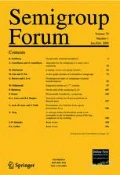Abstract
We introduce the concepts of S-sets and Q-sets for a flow (a group action on a compact metric space) and prove that a transitive flow is sensitive if and only if there exists an S-set with cardinality more than 2 and that each S-set of a transitive flow is a Q-set and the converse holds for minimal flows. Then according to cardinalities of S-sets, transitive flows are divided into several classes and some characterizations and relationships of different classes are given. This is a generalization of the \(\mathbb {Z}\)-action of Ye and Zhang (Nonlinearity 21:1601–1620, 2008. https://doi.org/10.1088/0951-7715/21/7/012).
Similar content being viewed by others
References
Akin, E., Kolyada, S.: Li-Yorke sensitivity. Nonlinearity 16, 1421–1433 (2003). https://doi.org/10.1088/0951-7715/16/4/313
Auslander, J., Guerin, M.: Regional proximality and the prolongation. Forum Math. 9, 761–774 (1997). https://doi.org/10.1515/form.1997.9.761
Auslander, J.: Minimal Flows and Their Extensions. North-Holland Mathematics Studies, vol. 153. North-Holland, Amsterdam (1988)
Chen, Z., Dai, X.: Chaotic dynamics of minimal center of attraction of discrete amenable group actions. J. Math. Anal. Appl. 456, 1397–1414 (2017). https://doi.org/10.1016/j.jmaa.2017.07.053
Dai, X., Tang, X.: Devaney chaos, Li-Yorke chaos and multi-dimensional Li-Yorke chaos for topological dynamics. J. Differ. Equ. 263, 5521–5553 (2017). https://doi.org/10.1016/j.jde.2017.06.021
Glasner, S.: Proximal Flows. Lecture Notes in Mathematics, vol. 517. Springer, New York (1976)
Huang, W., Khilko, D., Kolyada, S., Zhang, G.: Dynamical compactness and sensitivity. J. Differ. Equ. 260, 6800–6827 (2016). https://doi.org/10.1016/j.jde.2016.01.011
Kontorovich, E., Megrelishvili, M.: A note on sensitivity of semigroup actions. Semigroup Forum 76, 133–141 (2008). https://doi.org/10.1007/s00233-007-9033-5
Miralles, A., Murillo-Arcila, M., Sanchis, M.: Sensitive dependence for nonautonomous discrete dynamical systems. J. Math. Anal. Appl. 463, 268–275 (2018). https://doi.org/10.1016/j.jmaa.2018.03.022
Petersen, K.E.: Disjointness and weak mixing of minimal sets. Proc. Am. Math. Soc. 24, 278–280 (1970). https://doi.org/10.2307/2036347
Polo, F.: Sensitive dependence on initial conditions and chaotic group actions. Proc. Am. Math. Soc. 138, 2815–2826 (2010). https://doi.org/10.1090/S0002-9939-10-10286-X
Shao, S., Ye, X., Zhang, R.: Sensitivity and regionally proximal relation in minimal systems. Sci. China Ser. A 51, 987–994 (2008). https://doi.org/10.1007/s11425-008-0012-4
Subrahmonian Moothathu, T.K.: Stronger forms of sensitivity for dynamical systems. Nonlinearity 20, 2115–2126 (2007). https://doi.org/10.1088/0951-7715/20/9/006
Wang, H., Long, X., Fu, H.: Sensitivity and chaos of semigroup actions. Semigroup Forum 84, 81–90 (2012). https://doi.org/10.1007/s00233-011-9335-5
Wu, X., Chen, G.: Sensitivity and transitivity of fuzzified dynamical systems. Inform. Sci. 396, 14–23 (2017). https://doi.org/10.1016/j.ins.2017.02.042
Xiong, J.: Chaos in a topologically transitive system. Sci. China Ser. A 48, 929–939 (2005). https://doi.org/10.1360/04ys0120
Ye, X., Yu, T.: Sensitivity, proximal extension and higher order almost automorphy. Trans. Am. Math. Soc. 370, 3639–3662 (2018). https://doi.org/10.1090/tran/7100
Ye, X., Zhang, R.: On sensitive sets in topological dynamics. Nonlinearity 21, 1601–1620 (2008). https://doi.org/10.1088/0951-7715/21/7/012
Zhu, H., Liu, L., Wang, J.: A note on stronger forms of sensitivity for inverse limit dynamical systems. Adv. Diff. Equ. 101, 9 (2015). https://doi.org/10.1186/s13662-015-0425-7
Author information
Authors and Affiliations
Corresponding author
Additional information
Communicated by Jimmie D. Lawson.
Publisher's Note
Springer Nature remains neutral with regard to jurisdictional claims in published maps and institutional affiliations.
This work was supported by the National Natural Science Foundation of China (Grant Nos. 11661054, 12061043).
Rights and permissions
About this article
Cite this article
Ding, Z., Nie, X. & Yin, J. On sensitive sets and regionally proximal sets of group actions. Semigroup Forum 102, 408–421 (2021). https://doi.org/10.1007/s00233-021-10172-3
Received:
Accepted:
Published:
Issue Date:
DOI: https://doi.org/10.1007/s00233-021-10172-3



